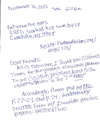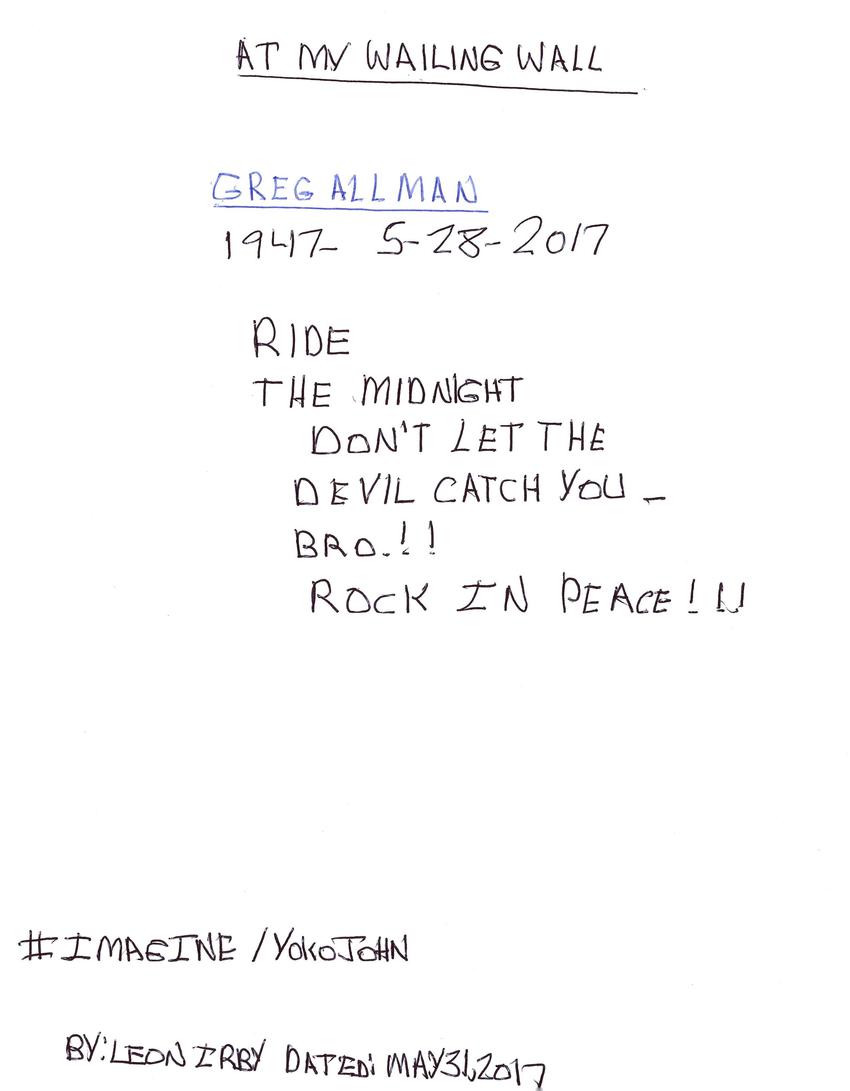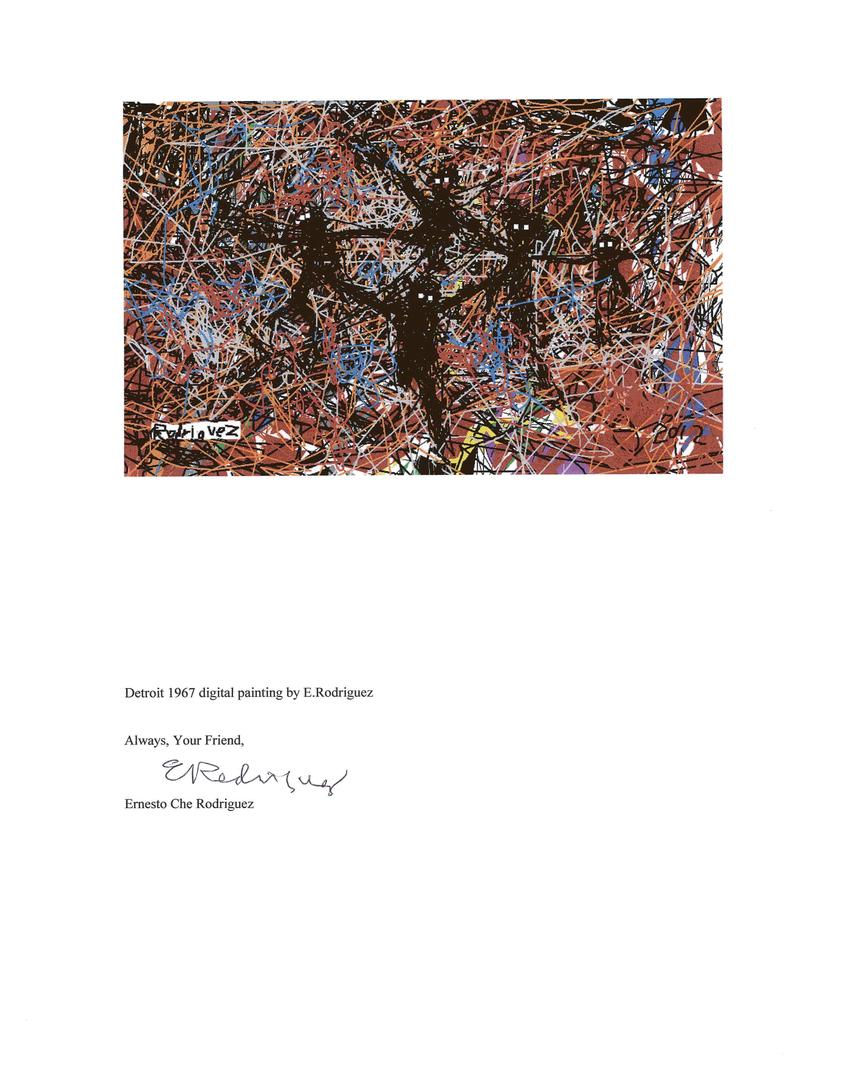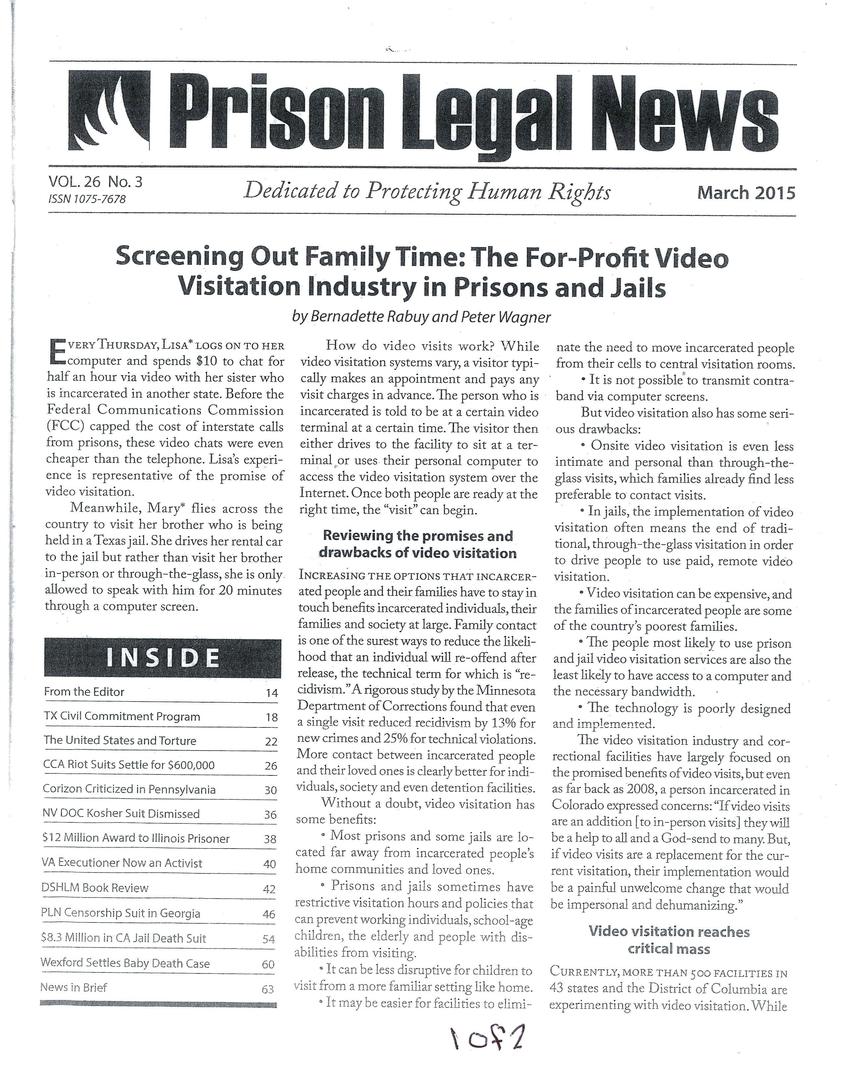
Transcription
I HOPE SOMEONE
GETS
MY MESSAGE...
IN THE..."
UNIVERSE!!!
Come
as you are
fall in his
arms
AT MY WAILING WALL
GREG ALLMAN
1947- 5-28-2017
RIDE
THE MIDNIGHT
DON'T LET THE
DEVIL CATCH YOU_
BRO.!!
ROCK IN PEACE!!!
#IMAGINE/YOKOJOHN
BY: LEON IRBY DATED: MAY 31, 2017
THE LADY HAS SOMETHING TO SAY!!!
I try to remind myself that
these are just people hiding
behind
a screen,
saying things
they would
never say
to your face."
On conquering
her internet trolls,
KESHA
USMAGAZINE.COM/LOOSETALK
APRIL 3, 2017, P.6
[image]
Detroit 1967 digital painting by E. Rodriguez
Always, Your Friend,
ERodriquez
Ernesto Che Rodriguez
Prison Legal News
VOL. 26 No. 3
ISSN 1075-7678
Dedicated to Protecting Human Rights March 2015
Screening Out Family Time: The For-Profit Video
Visitation Industry in Prisons and Jails
by Bernadette Rabuy and Peter Wagner
INSIDE
From the Editor 14
TX Civil Commitment Program 18
The United States and Torture 22
CCA Riot Suits Settle for $600,000 26
Corizon Criticized in Pennsylvania 30
NV DOC Kosher Suit Dismissed 36
$12 Million Award to Illinois Prisoner 38
VA Executioner Now an Activist 40
DSHLM Book Review 42
PLN Censorship Suit in Georgia 46
$8.3 Million in CA Jail Death Case 54
Wexford Settles Baby Death Case 60
News in Brief 63
EVERY THURSDAY, LISA* LOGS ON TO HER computer and spends $10 to chat for half an hour via video with her sister who is incarcerated in another state. Before the Federal Communications Commission (FCC) capped the cost of interstate calls from prisons, these video chats were even cheaper that the telephone. Lisa's experience is representative of the promise of video visitation.
Meanwhile, Mary* flies across the country to visit her brother who is being held in a Texas jail. She drives her rental car to the jail but rather than visit her brother in-person or through-the-glass, she is only allowed to speak with him for 20 minutes through a computer screen.
How do video visits work? While video visitation systems vary, a visitor typically makes an appointment and pays any visit charges in advance. The person who is incarcerated is told to be at a certain video terminal at a certain time. The visitor then either drives to the facility to sit at a terminal or uses their personal computer to access the video visitation system over the Internet. Once both people are ready at the right time, the "visit" can begin.
Reviewing the promises and drawbacks of video visitation
INCREASING THE OPTIONS THAT INCARCERATED people and their families have to stay in touch benefits incarcerated individuals, their families and society at large. Family contact is one of the surest ways to reduce the likelihood that an individual will re-offend after release, the technical term for which is "recidivism". A rigorous study by the Minnesota Department of Corrections found that even a single visit reduced recidivism by 13% for new crimes and 25% for technical violations. More contact between incarcerated people and their loved ones is clearly better for individuals, society and even detention facilities.
Without a doubt, video visitation has some benefits:
- Most prisons and some jails are located far away from incarcerated people's home communities and loved ones.
- Prisons and jails sometimes have restrictive visitation hours and policies that can prevent working individuals, school-age children, the elderly and people with disabilities from visiting.
- It can be less disruptive for children to visit from a more familiar setting like home.
- It may be easier for facilities to eliminate the need to move incarcerated people from their cells to central visitation rooms.
- It is not possible to transmit contraband via computer screens.
But video visitation also has some serious drawbacks:
- Onsite video visitation is even less intimate and personal than through-the-glass visits, which families already find less preferable to contact visits.
- In jails, the implementation of video visitation often means the end of traditional, through-the-glass visitation in order to drive people to use paid, remote video visitation.
- Video visitation can be expensive, and the families of incarcerated are some of the country's poorest families.
- The people most likely to use prison and jail video visitation services are also the least likely to have access to a computer and the necessary bandwidth.
- The technology is poorly designed and implemented.
The video visitation industry and correctional facilities have largely focused on the promised benefits of video visits, but even as far back as 2008, a person incarcerated in Colorado expressed concerns: "If video visits are an addition [to in-person visits] they will be a help to all and a God-send to many. But, if video visits are a replacement for the current visitation, their implementation would be a painful unwelcome change that would be impersonal and dehumanizing."
Video visitation reached critical mass
CURRENTLY, MORE THAN 500 FACILIITIES IN 43 states and the District of Columbia are experimenting with video visitation. While prior litigation. Ackerman later amended his complaint to include a claim of being transferred to another prison and denied the then-still-available kosher meals in retaliation for filing his lawsuit.
The district court entered an injunction to prevent the DOC from serving non-kosher meals to Ackerman or any of the other Jewish prisoners receiving kosher meals who were affected by the DOC's policy change.
The parties then agreed to settle the case. The settlement would require the DOC to receive kosher certification of prison kitchen facilities by the non-profit organization Scroll K / Vaad Hakashrus. Kosher meals would have to be made available to class members, be certified by a rabbi as being kosher and certified by a DOC-hired nutritionist as providing "proper nutritional values for the dietary requirements of an adult male between the ages of 21-55 years with moderate physical activity (30 minutes or more)." The settlement further required the DOC to maintain the certifications and to make the kosher meal plan available to class members in minimum-security facilities and conversation camps as well as higher-security prisons.
In preparation for the proposed settlement, the district court approved a notice to be distributed to DOC prisoners that included information on how to file objections. Many Jewish prisoners did just that.
Nearly 300 DOC prisoners were receiving kosher meals under the prior federal litigation. Forty-five objected to the new kosher meals under the prior federal litigation. Forty-five objected to the new kosher meal plan on the grounds that the food, which would be prepared in kosher-certified prison kitchens, was not up to the standards of meals served to the rest of the DOC population and lacked nutritional value. The court held a fairness hearing on October 11, 2012 and took the matter under advisement.
The Nevada Board of Examiners had approved contracts to provide kosher prison kitchens and rabbinical supervision of kosher food preparation; however, on May 3, 2013 the district court rejected the proposed settlement agreement and dissolved the preliminary injunction. The court also decertified the class.
Ackerman filed emergency objections seeking reconsideration, stating the court had "stripped the Plaintiffs of their guarantee to receive kosher food, a protected First Amendment right, dissolved a class which this Court had already certified, and rejected a settlement agreement based on concerns raised by certain class members about issues that are not even relevant or a part of the instant action." The motion for reconsideration was denied in December 2013.
The defendants filed a motion to dismiss or for summary judgment on April 28, 2014, which was granted by the district court in August 2014 because plaintiffs' counsel had failed to file a response to the motion. Under a local court rule, "[t]he failure of an opposing party to file points and authorities of an opposing party to file points and authorities in response to any motion shall constitute a consent to the granting of the motion."
Ackerman has since appealed the dismissal to the Ninth Circuit, and his appeal remains pending. See: Ackerman v. State of Nevada Department of Corrections, U.S.D.C. [D.Nev.), Case No.2:11-cv-00883-GWN-PAL.
Additional source: www.jta.org
Is someone skimming money
or otherwise charging you and your loved ones
high fees to deposit money into your account?
Prison Legal News (PLN) is collecting information about the ways that family members of incarcerated people get cheated by the high cost of sending money to fund inmate accounts.
Please write to PLN, and have your people in the outside contact us as well, to let us know specific details about the way that the system is ripping them off, including:
- Fees to deposit money on prisoners' accounts or delays in receiving no-fee money orders
- Costly fees to use pre-paid debit cards upon release from custody
- Fees charged to submit payment for parole supervision, etc.
This effort is part of the Human Rights Defense Center's Stop Prison Profiteering campaign, aimed at exposing business practices that result in money being diverted away from the friends and family members of prisoners.
NI
NATION INSIDE
Friends and families of prisoners can follow this effort, which is part of the Nation Inside network, at
WWW.STOPPRISONPROFITEERS.ORG
Please direct all related correspondence to PTSOLKAS@PRISONLEGALNEWS.ORG
Call (561) 360-2523, or send mail to PLN
Prison Legal News
Attn: Panagioti Tsolkas
PO Box 1151
Lake Worth, Florida 33460
Prison Legal News 2 of 2 March 2015
POSTED: BY: LEON IRBY MAY 31, 2017
Other posts by this author
|
2023 feb 1

|
2022 dec 14

|
2022 dec 12

|
2022 dec 10

|
2022 aug 31

|
2022 jun 22

|
More... |







Replies